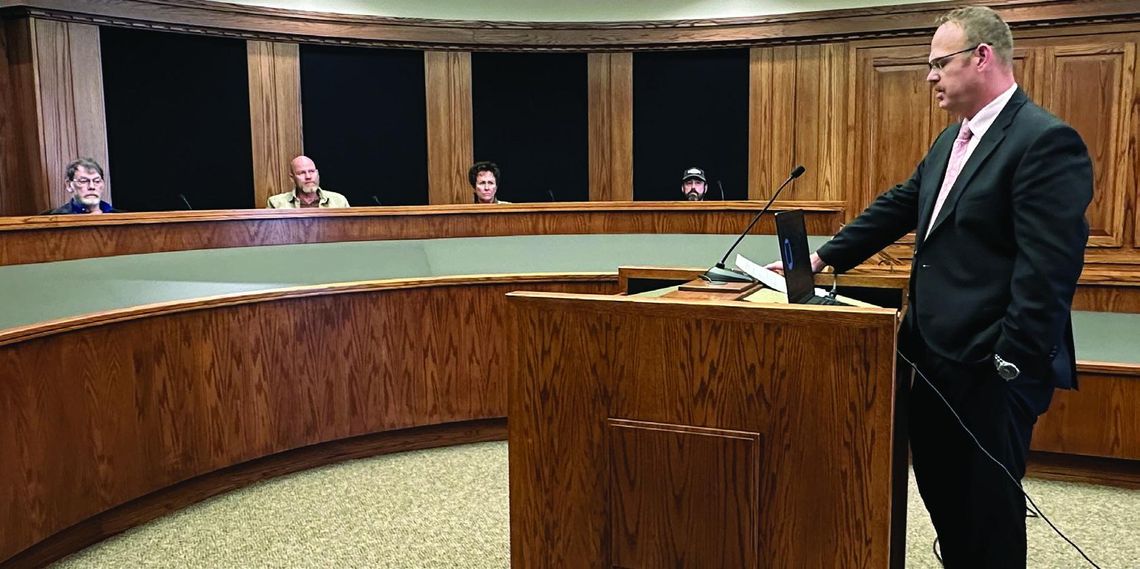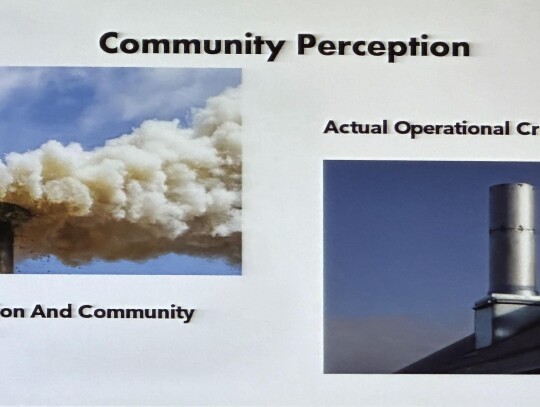Elk City’s Chris Whinery’s recent permit request concerning the construction of a crematory was the only item on the agenda at the Tues, March 26th, Elk City Planning and Zoning Board, at 6 p.m., in City Hall. The area has been zoned C-2, Highway Commercial and Commercial Recreation District, since 1995. The issue became under scrutiny with a written protest from Richard and Tammy Dugger of Martin – Dugger Funeral Home. After hearing from both sides of the proposed construction, the board voted to approve a crematory being located in a C-2 Highway Commercial and Commercial Recreation zoning.
The chairman of the Planning and Zoning Board, Tom Johnson, received the letter protesting the addition of a crematory to the property from the Duggers on Friday, March 22nd. The letter outlined a series of concerns that they had concerning the construction of the crematory within the limits of Elk City. It said that the project poses significant risks to the community.
Johnson read the letter of protest at the beginning of the hearing. Dugger was not present to talk on the matter directly to the board. Johnson read the letter in its entirety.
The concerns Dugger wrote included health and environmental concerns. The letter stated that crematories emit pollutants that include mercury, particulate matter and volatile organic compounds and the proposed project is near residential areas.
The next concern was about property values and quality of life. He believes the crematory would negatively affect property values and the noise, traffic, and visual impact could diminish the overall quality of life. He also wrote that community perception would be a problem because Elk City is known to be friendly and family oriented. The project would alter that image.
Dugger also said in the letter that there should be alternative locations for the crematory. He urged the board to consider areas away from residential zone, parks, and schools. It should be in a commercial area. He was also concerned with regulation and oversight. He said that although it can operate safely under proper regulations, there needs to be overseeing to protect the community, as well as regular monitoring.
He also provided a list of pollutants that he believed would be emitted from the crematory. The ones Dugger mentioned were carbon dioxide (CO2), particulate matter (PM), volatile organic compounds (VOCs), Oxides of Nitrogen (NOX), Oxides of Sulfur (SOX), and Toxic Air Contaminants (TACs).
Dugger concluded the letter by asking the board to reconsider the permit approval and said that the neighborhood has changed since the approval of the C-2 zoning classification in 1991.
After reading the letter, Johnson asked for anyone who wished to speak against the proposal to come before the board to give them their opinion on the subject. Haley Price stepped up and told them her concerns about the crematory, which would be located behind her home.
“I understood that there was a funeral home there when I built my house in Fox Ridge. However, I did not realize that there could be the opportunity for a crematory to be there. My main concern is polluting the area. I know there is research backing that it doesn’t have pollutants, however it makes me a little skeptical about the managing and oversight,” Price said.
She continued to say that chemical pollution and odor would be in question. She is fine with the funeral home, but the crematory concerns her.
Johnson then asked if anyone else wanted to talk against the project. No one else stepped forward. Johnson went on to give the board some national statistics. He noted that nationally 60 percent are getting cremated, and in Oklahoma the number is a rough 23 percent. Oklahoma also has the 12th fastest growing population rate for the past few years. Johnson added that by 2045, they project that number to grow to 80 percent.
He continued to ask for anyone else to speak against the proposed crematory to come forward. No one else came forward. Johnson then asked city Inspector Gary Nix to speak on the research he has done with other cities and inspectors across the state.
Nix said that he has contacted several cities who have crematories within the city limits. He asked them about the permits, the complaints, and the zoning in those towns. He said that everything will be processed, permitted, and regulated through the EPA and DEQ. The towns and inspectors that he contacted said that most people do not know that they are there or noticeable. Some of them are in proximity of homes, shopping, and other commercial properties. Of all the towns he spoke to there was one complaint for emissions. Nix found that other towns’ zoning codes were also commercially zoned, such as Enid, Altus, Oklahoma City, The next person to talk to the board was Chris Whinery. He gave a brief introduction to his own history and the history of the funeral home. He said he respects the Duggers and their opinion; he also thanked Price for attending the meeting and giving her opinion.
Whinery went on to talk about the options that families deserve to have when deciding on final services. Whether it is traditional burial or cremation, he said that it is about options and helping families. He also talked about how the 2020 pandemic changed the way they do business within the regulations that came from the governor.
“Last year, 2023, I had the opportunity to serve over 200 families in and around Elk City. Of those 200 families, close to 50 percent chose cremation as the final disposition for their loved one. As a member of this community, I’ve been left with two questions that I’ve continued to ask myself. One, have I provided these families with the closure they needed, and number two, doesn’t Western Oklahoma deserve more?” Whinery said, He also invited anyone who may have concerns about the future plans to contact him personally to discuss them. Whinery went on to address each of the concerns in the protest letter.
“Through my research, there are a wide variety of views and values concerning this issue. Much like any other issues in America, you have supporters, and you have opposition. So to begin, I would like to put this in the simplest terms possible. Flame based cremation is a fossil fuel driven process, meaning it does require the use of natural gas or some fuel for the sole purpose of combustion,” he continued.
One cremation is estimated to produce 535 pounds of carbon dioxide through the entire two-hour process it takes for the cremation. Whinery compared that to emissions of a passenger car. He went on to talk about each of the other chemicals that were cited in the protest letter, through his presentation slides.
After going over each of the emission concerns, Whinery talked about the regulatory oversight and the particular crematory he will be purchasing. He showed the diagram of the machine and said that each cremation will be monitored by him and the manufacturer in Florida.
“I can tell you as a human being, we like options. We’d like the option to make our own choices in everything from the food we eat, to when we lay our head down at night. Options and choices bring peace of mind, and with that it dissolves anxiety,” Whinery added.
He also talked about alternative locations, which he believes should be located at the funeral home. The proximity to the chapel, Fairlawn Cemetery, and the amount of traffic would be no more or less because of the crematory. The zoning is the same as when his father owned the funeral home in 1995. Additionally, he will be regulated by DEQ and EPA, as well as the state funeral board.
“This piece of equipment will have certificates stated from the United States Environmental Protection Agency for the EPA. That will place regulations and qualifications on this piece of equipment. I am excited about this project, and with the approval of the board and with the community support, I would like to show you all my research. I’ve been to various places, and the one that I have found and settled on and hope to order within the week is from the Matthews Corporation. It is the Power Pack One, and it is paired with Empower technology. Basically, this is connected by the internet to the Matthews facility in Florida.” he said.
With the conclusion of Whinery’s presentation, Johnson opened the board meeting, where they approved the minutes from the Oct. 31st meeting. They then voted to approve the crematory being located in the C-2 zoning. The members of the board present were Pat Browning, Paul Currell, Todd Horn, Robbie Allen, Damon Culver, and chairman Tom Johnson. Kelci Werner was absent. The vote was affi rmative by all members, with one abstention by Culver because he will be the contractor for the project, therefore, it went as a nay vote.
The meeting adjourned at 7 p.m.




